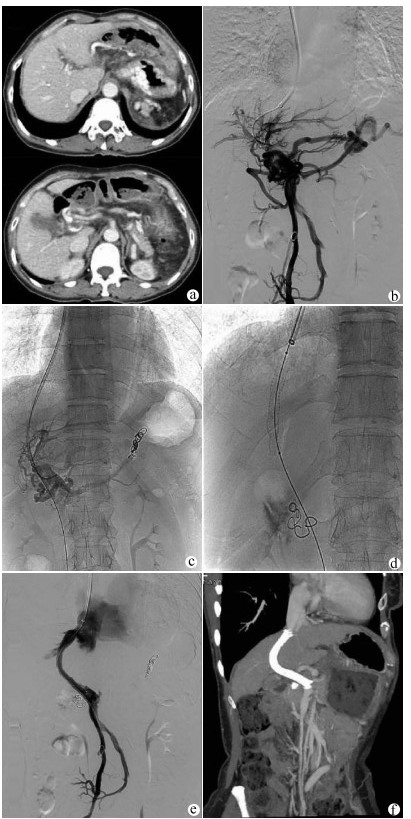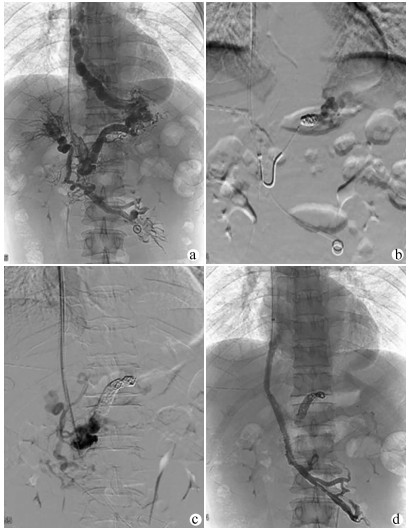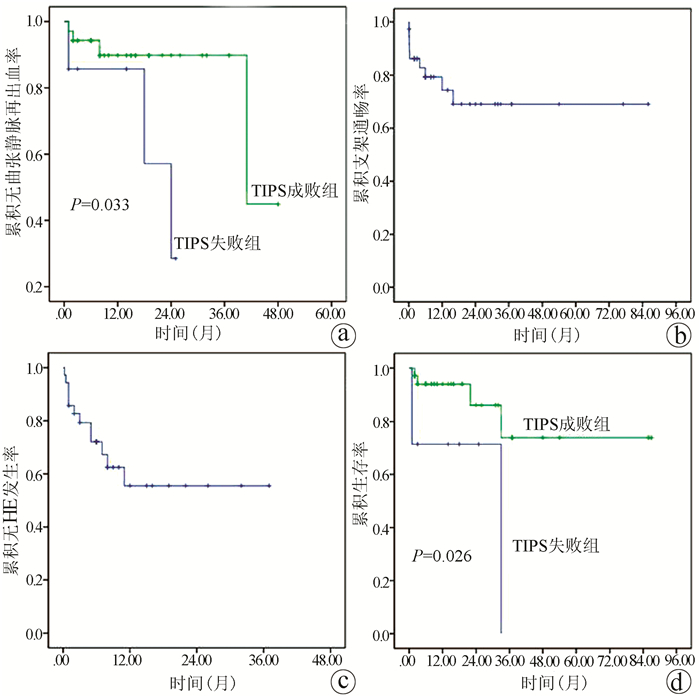| [1] |
LUO J, LI M, ZHANG Y, et al. Percutaneous transhepatic intrahepatic portosystemic shunt for variceal bleeding with chronic portal vein occlusion after splenectomy[J]. Eur Radiol, 2018, 28(9): 3661-3668. DOI: 10.1007/s00330-018-5360-z. |
| [2] |
MAKDISSI FF, HERMAN P, MACHADO MA, et al. Portal vein thrombosis after esophagogastric devascularization and splenectomy in schistosomal portal hypertension patients: What's the real importance?[J]. Arq Gastroenterol, 2009, 46(1): 50-56. DOI: 10.1590/s0004-28032009000100014. |
| [3] |
DANNO K, IKEDA M, SEKIMOTO M, et al. Diameter of splenic vein is a risk factor for portal or splenic vein thrombosis after laparoscopic splenectomy[J]. Surgery, 2009, 145(5): 457-464; discussion 465-466. DOI: 10.1016/j.surg.2008.06.030. |
| [4] |
IKEDA M, SEKIMOTO M, TAKIGUCHI S, et al. High incidence of thrombosis of the portal venous system after laparoscopic splenectomy: A prospective study with contrast-enhanced CT scan[J]. Ann Surg, 2005, 241(2): 208-216. DOI: 10.1097/01.sla.0000151794.28392.a6. |
| [5] |
HE S, HE F. Predictive model of portal venous system thrombosis in cirrhotic portal hypertensive patients after splenectomy[J]. Int J Clin Exp Med, 2015, 8(3): 4236-4242.
|
| [6] |
DIAO YP, YANG N, GUO LL, et al. Unconventional interventional therapy for cavernous transformation of the portal vein[J]. Ann Vasc Surg, 2014, 28(7): 1791. e9-1791. e11. DOI: 10.1016/j.avsg.2014.03.005. |
| [7] |
SENZOLO M, TIBBALS J, CHOLONGITAS E, et al. Transjugular intrahepatic portosystemic shunt for portal vein thrombosis with and without cavernous transformation[J]. Aliment Pharmacol Ther, 2006, 23(6): 767-775. DOI: 10.1111/j.1365-2036.2006.02820.x. |
| [8] |
LUCA A, MIRAGLIA R, CARUSO S, et al. Short- and long-term effects of the transjugular intrahepatic portosystemic shunt on portal vein thrombosis in patients with cirrhosis[J]. Gut, 2011, 60(6): 846-852. DOI: 10.1136/gut.2010.228023. |
| [9] |
RADOSEVICH PM, RING EJ, LABERGE JM, et al. Transjugular intrahepatic portosystemic shunts in patients with portal vein occlusion[J]. Radiology, 1993, 186(2): 523-527. DOI: 10.1148/radiology.186.2.8421759. |
| [10] |
LUO X, WANG Z, TSAUO J, et al. Advanced cirrhosis combined with portal vein thrombosis: A randomized trial of TIPS versus endoscopic band ligation plus propranolol for the prevention of recurrent esophageal variceal bleeding[J]. Radiology, 2015, 276(1): 286-293. DOI: 10.1148/radiol.15141252. |
| [11] |
FANELLI F, ANGELONI S, SALVATORI FM, et al. Transjugular intrahepatic portosystemic shunt with expanded-polytetrafuoroethylene-covered stents in non-cirrhotic patients with portal cavernoma[J]. Dig Liver Dis, 2011, 43(1): 78-84. DOI: 10.1016/j.dld.2010.06.001. |
| [12] |
QI X, HAN G, YE C, et al. Splenectomy causes 10-fold increased risk of portal venous system thrombosis in liver cirrhosis patients[J]. Med Sci Monit, 2016, 22: 2528-2550. DOI: 10.12659/msm.898866. |
| [13] |
WANG MQ, LIN HY, GUO LP, et al. Acute extensive portal and mesenteric venous thrombosis after splenectomy: Treated by interventional thrombolysis with transjugular approach[J]. World J Gastroenterol, 2009, 15(24): 3038-3045. DOI: 10.3748/wjg.15.3038. |
| [14] |
QI X, BAI M, GUO X, et al. Pharmacologic prophylaxis of portal venous system thrombosis after splenectomy: A meta-analysis[J]. Gastroenterol Res Pract, 2014, 2014: 292689. DOI: 10.1155/2014/292689. |
| [15] |
SONG B, MIN P, OUDKERK M, et al. Cavernous transformation of the portal vein secondary to tumor thrombosis of hepatocellular carcinoma: Spiral CT visualization of the collateral vessels[J]. Abdom Imaging, 2000, 25(4): 385-393. DOI: 10.1007/s002610000057. |
| [16] |
KINJO N, KAWANAKA H, AKAHOSHI T, et al. Risk factors for portal venous thrombosis after splenectomy in patients with cirrhosis and portal hypertension[J]. Br J Surg, 2010, 97(6): 910-916. DOI: 10.1002/bjs.7002. |
| [17] |
LUO X, NIE L, ZHOU B, et al. Transjugular intrahepatic portosystemic shunt for the treatment of portal hypertension in noncirrhotic patients with portal cavernoma[J]. Gastroenterol Res Pract, 2014, 2014: 659726. DOI: 10.1155/2014/659726. |
| [18] |
HAN G, QI X, HE C, et al. Transjugular intrahepatic portosystemic shunt for portal vein thrombosis with symptomatic portal hypertension in liver cirrhosis[J]. J Hepatol, 2011, 54(1): 78-88. DOI: 10.1016/j.jhep.2010.06.029. |
| [19] |
DONG F, LUO SH, ZHENG LJ, et al. Incidence of portal vein thrombosis after splenectomy and its influence on transjugular intrahepatic portosystemic shunt stent patency[J]. World J Clin Cases, 2019, 7(17): 2450-2462. DOI: 10.12998/wjcc.v7.i17.2450. |
| [20] |
WANG L, HE F, YUE Z, et al. Techniques and long-term effects of transjugular intrahepatic portosystemic shunt on liver cirrhosis-related thrombotic total occlusion of main portal vein[J]. Sci Rep, 2017, 7(1): 10868. DOI: 10.1038/s41598-017-11455-y. |
| [21] |
STAMOU KM, TOUTOUZAS KG, KEKIS PB, et al. Prospective study of the incidence and risk factors of postsplenectomy thrombosis of the portal, mesenteric, and splenic veins[J]. Arch Surg, 2006, 141(7): 663-669. DOI: 10.1001/archsurg.141.7.663. |















 DownLoad:
DownLoad:

